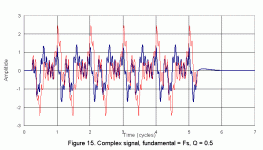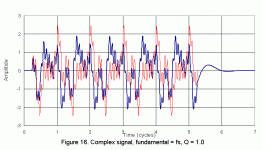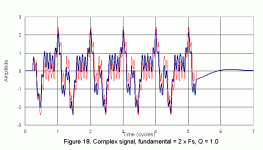Must be your browser. They show for me.
Can't see anything either, on three different browsers.
Can't say as I'm sure about how to think about Q, but I would point out that the perfect driver has no Q, so to say. Any "amount" of Q means the driver has a "voice" or sound characteristic and we want to strive for no voice at all in reproducing signals. Isn't that obvious?
And on the other hand, Q arises from features of driver design/manufacture. Some classical woofers that seem good to me have light cones and large magnets and maybe the Q is high. Mounting a driver (enclosed or not) means working with the selected driver's Q or choosing a Q that seems more harmonious with the intended mounting.
In that sense, there's no "correct" Q, just a correct tendency-of-Q. For sure, total nonsense to think there's some auditory correctness to a Q=1, which only has computational simplicity and not audiophile benefits.
And on the other hand, Q arises from features of driver design/manufacture. Some classical woofers that seem good to me have light cones and large magnets and maybe the Q is high. Mounting a driver (enclosed or not) means working with the selected driver's Q or choosing a Q that seems more harmonious with the intended mounting.
In that sense, there's no "correct" Q, just a correct tendency-of-Q. For sure, total nonsense to think there's some auditory correctness to a Q=1, which only has computational simplicity and not audiophile benefits.
Last edited:
Can't say as I'm sure about how to think about Q, but I would point out that the perfect driver has no Q, so to say. Any "amount" of Q means the driver has a "voice" or sound characteristic and we want to strive for no voice at all in reproducing signals. Isn't that obvious?
And on the other hand, Q arises from features of driver design/manufacture. Some classical woofers that seem good to me have light cones and large magnets and maybe the Q is high. Mounting a driver (enclosed or not) means working with the selected driver's Q or choosing a Q that seems more harmonious with the intended mounting.
In that sense, there's no "correct" Q, just a correct tendency-of-Q. For sure, total nonsense to think there's some auditory correctness to a Q=1, which only has computational simplicity and not audiophile benefits.
Q is just a factor for a 2nd order system, HP, L, or a 2nd order parametric Eq, for example. A 4th order system can be factored in to two 2nd order systems, each with its own Q, and similarly for other orders. A perfect driver with no Q would necessarily be flat from DC to infinity with no resonances. But a sufficiently wide band pass response will have a region with flat amplitude and close to zero phase.
And don't forget, your CD or digital audio player, phono preamp, preamp, power amp, recording mic, and all other recording equipment have there own bandwidth limitations thus imposing phase shifts on the recorded signal that weren't present in the original acoustic event. That's why all this is fun to talk about but in reality it doesn't mean a hill of beans because no matter what the speaker does, it's just another component which imposes its signature on the original music. The input signal is effed up to start with.
How about now?
Hmmm thats interesting
As for the sense of "slam" . Every speaker I have ever built had a greater sense of slam ( not nessasarily a better overall sound) with a smaller bass driver coil
Perhaps simply a power response thing?
BTW the greatest slam I have ever heard was a limp , no tension at all, and Waaayyy heavy and well damped planer magnetic diaphragm running dipole and full range. I have never heard anything that "sounded" as "fast". Very close to live drum kit in the room
in another strange experiment of extremes I added weight to an 8 in woofer till fs was around 5 hz. Peak volume may have been only 80-85 db BUT I have heard no speaker with a better sense of "depth" of space.
Last edited:
@john k...; They dont show for me either - just sits and spins. Why not attach in the ordinary uploaded way using "Go Advanced"?
@bentoronto; - "Anyone who has tried MFB will nod when I say: in the future, people will look back on non-feedback speakers as crude indeed, just as we look back on amps from early in the 20th century."
Back in the 70's Phillips made the RH541 among other motional feedback powered units. Oh, how I wanted one as a kid when I first heard about it! I was certain that was the way to go!
So, what happened? If the idea was so great, why was it so eschewed that Phillips quit in short order? People prefer using their own amps, period? Right place at the Wrong time?
What I've read is that a properly tuned system based on zero feedback will always trump a feedback servo. Has something to do with the general caveat that "an amp designed with good open loop behavior - and a little feedback - sounds better than am amp designed with poor open loop behavior - and a ton of feedback to correct it.
I remember being so happy that these small Phillips speakers could achieve the claimed low end response (35...) in such a small package. The next evolutionary step up from the AR1, 3A. I guess the "forced nature" of the sound must have been quite evident, else they should have taken over the audio world in that "never going back" way as you imply.
Just read Pink Floyd mixed "The Wall" using one of these Phillips motional feedback speaker sets...
@bentoronto; - "Anyone who has tried MFB will nod when I say: in the future, people will look back on non-feedback speakers as crude indeed, just as we look back on amps from early in the 20th century."
Back in the 70's Phillips made the RH541 among other motional feedback powered units. Oh, how I wanted one as a kid when I first heard about it! I was certain that was the way to go!
So, what happened? If the idea was so great, why was it so eschewed that Phillips quit in short order? People prefer using their own amps, period? Right place at the Wrong time?
What I've read is that a properly tuned system based on zero feedback will always trump a feedback servo. Has something to do with the general caveat that "an amp designed with good open loop behavior - and a little feedback - sounds better than am amp designed with poor open loop behavior - and a ton of feedback to correct it.
I remember being so happy that these small Phillips speakers could achieve the claimed low end response (35...) in such a small package. The next evolutionary step up from the AR1, 3A. I guess the "forced nature" of the sound must have been quite evident, else they should have taken over the audio world in that "never going back" way as you imply.
Just read Pink Floyd mixed "The Wall" using one of these Phillips motional feedback speaker sets...
Last edited:
How about now?
These show but the original ones showed earlier today but not any more.
Since the effects of rooms were brought up here are some simulation for a monopole, dipole and cardioid woofer with 20 Hz, Q=0.5 HP and 120 Hz, B4 LP response. The green traces are the impulse response of the woofer w/o room effects. The blue is what you get at the listening position. "Aligned" means the axis of the dipole or cardioid is aligned with a room axis, front to rear.
Mono pole
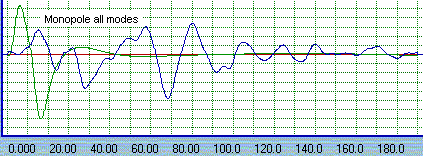
Dipole
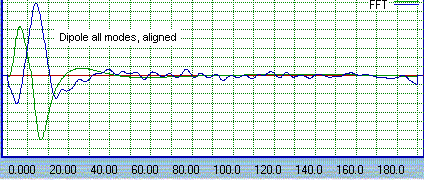
Cardioid
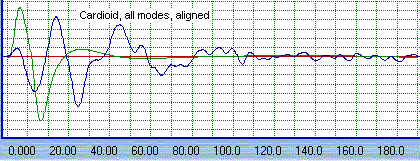
If you angle the dipole and cardioid at 45 degrees (toed in) this is what you get.
Dipole 45*
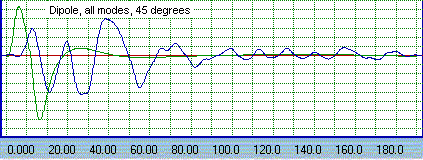
Cardioid 45*
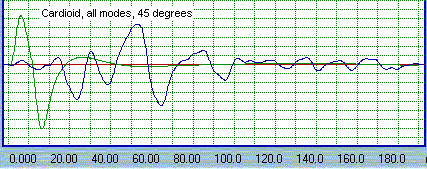
Mono pole

Dipole

Cardioid

If you angle the dipole and cardioid at 45 degrees (toed in) this is what you get.
Dipole 45*

Cardioid 45*

Last edited:
Since the effects of rooms were brought up here are some simulation for a monopole, dipole and cardioid woofer with 20 Hz, Q=0.5 HP and 120 Hz, B4 LP response. The green traces are the impulse response of the woofer w/o room effects. The blue is what you get at the listening position. "Aligned" means the axis of the dipole or cardioid is aligned with a room axis, front to rear.
Thanks for posting these plots, John. Quite an interesting difference between the "aligned with room axis" and the "45 deg to room axis" time domain responses for a dipole source...
Besides that the room dominates the Q of what you actually hear, half a second is exeptionaly good at 50Hz, how about the music signal itself.
Powerfull bass notes last often more than 0.5 sec.
And if you read Toole, you'll see that high Q's are not very audible.
Powerfull bass notes last often more than 0.5 sec.
And if you read Toole, you'll see that high Q's are not very audible.
wow that aligned dipole response looks very good! i have only very shortly tried dipole bass and did not like the complexity of the active setup, is it possible to go passive and still get decent bass output?
The problem with the passive approach is that with a dipole woofer and the 6dB/oct roll off you can only flatten the response with attenuation. Using the dipole = monopole (d=m) frequency as a reference, if you want to extend the bass 2 octave below the d=m frequency you need to actively increase the gain below the d=m and attenuate above that frequency at 6dB/oct. This means the net effect is that the system sensitivity for the midrange and up will be that of the woofer's monopole sensitivity. But if you do that passively you can only attenuate which means the d=m point will be attenuated by 12 dB and the midrange and up will also have to be attenuated which wastes a lot of amplifier voltage swing. The way around it, as you often see in passive dipole systems is numerous, large, high sensitivity woofers on large baffles so that after attenuation the sensitivity at the d=m frequency is still in the 88 to 90 db/volt range.wow that aligned dipole response looks very good! i have only very shortly tried dipole bass and did not like the complexity of the active setup, is it possible to go passive and still get decent bass output?
The next problem is that due to the large baffles such system don't really behave as dipoles at higher frequencies (midrange and mid bass) hence they are typically called open baffle systems. That doesn't mean they don't sound good. If you look at the Ultimate Open Baffle thread you can see that just about any configuration of a group of drivers on a piece of plywood can be made to sound good to someone's ear. 🙂
Last edited:
This is some, and no disrespect, reflex tripod mounted Genelec 8" bass plus horn 1" Disco speaker with electronic crossover?
Reflex sounds like the rhythm section is a quarter of a beat behind the sax and trumpet, and it's confusing. Technically 15ms is about 10 yards spatial displacement. I think the idea is the lead follows the rhythm, but I'm not a musician. But good musicians are extraordinarily sensitive to timing. I think it was Count Basie who said "It don't mean a thing if it ain't got that swing!".
:
First, that "disco" speaker is a studio monitor that comes from a company that has more speakers in hi end recording and mastering studios than anyone else. Doubt they have the problem you refer too.
If your saying the low end is behind the hi freqs than part of the bass and kick drum ( they both have very audible freqs above 1 khz ) are seperated in time. Many bass cabs are ported. You think the musicians woudnt notice? This is just wrong. PRAT is total bs made up by ignorant reviewers.
Q is just a factor for a 2nd order system, HP, L, or a 2nd order parametric Eq, for example. A 4th order system can be factored in to two 2nd order systems, each with its own Q, and similarly for other orders. A perfect driver with no Q would necessarily be flat from DC to infinity with no resonances. But a sufficiently wide band pass response will have a region with flat amplitude and close to zero phase. ...
Here is an example of an erudite rendition of Pure Physics Theory who, in the last sentence, is oblivious to the reality that the wide band condition he specifies is met by approximately 0% of subs in the known universe*.
B.
*OK, I know there is a driver with a resonance at 10 Hz if you can find it
...Back in the 70's Phillips made the RH541 among other motional feedback powered units. Oh, how I wanted one as a kid when I first heard about it! I was certain that was the way to go!
So, what happened? ....
What I've read is that a properly tuned system based on zero feedback will always trump a feedback servo....
As I say almost every time I mention Philips, they took a junky speaker in a cheap box and using a 10-cent piece of piezo ceramic and tried to make "a silk purse" out of it. They were very successful in making it pretty good as many Dutch enthusiasts and others will attest.
As far as your declaration about the "always", gotta say that in 53 years of interest in MFB, I can never recall anybody who has worked with MFB say anything but the exact opposite of what you seem to think.
B.
- Home
- Loudspeakers
- Multi-Way
- Back to Transients. Understanding "Q" and myths of bass
